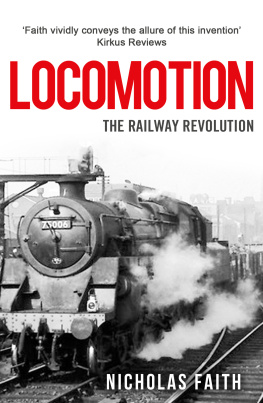Locomotion: The Railway Revolution
Nicholas Faith
Nicholas Faith 1993
Nicholas Faith has asserted his rights under the Copyright, Design and Patents Act, 1988, to be identified as the author of this work.
First published in 1993 by BBC Books, a division of BBC Enterprises Limited.
This edition published in 2017 by Endeavour Press Ltd.
Table of Contents
Introduction
It seems to me as if this railway were the one typical achievement of the age in which we live, as if it brought together into one plot all the ends of the world and all the degrees of social rank and offered to some great writer the busiest, the most extended, and the most varied subject for an enduring literary work. If it be romance, if it be contrast, if it be heroism that we require, what was Troy town to this?
In his travel notes (collected as The Amateur Emigrant ) Robert Louis Stevenson posed a challenge, to which no single author, however talented, could ever adequately respond. For, in the words of the old newspaper slogan, all human life is here, clustered along the tracks, on the footplate, in the open carriages and closed compartments of the trains themselves, riding the rails, working for the railways, lurking in the stations.
The effects of the railways on society are too universal and long-lasting to be compressed within a single volume. Like some many-headed Hindu god they contain life and death, creation and destruction, squalor and magnificence. All I can do is to sketch some of the more interesting aspects, to provide my readers with food for thought, to enable them to look more closely, not so much at the railways they use, as at the townscape and landscape around them, and to detect their still all-pervasive influence.
The railway was the first, the most universal and the most dramatic mechanical intrusion into the lives of peoples and nations, the first of the technical revolutions which created the world as we know it today. It was also the most fundamental, the most long-lasting, for it was the first time that man, through sheer mechanical ingenuity, had been able to impose his will on nature and thus transform his relationship with nature. Yet (and this, perversely, is a recurrent theme running through this book) even this, the first such innovation, could not dramatically alter human nature and, as we shall see, the railways carried with them their own limitations. Their power was neither total nor infinite.
Curiously, and notably unlike later major inventions which have transformed mans relationship with nature from the internal combustion engine, through radio to television, the jet engine, the computer and the silicon chip the actual innovations required to develop a steam locomotive riding on iron wheels on an iron road were not in themselves dramatic or revolutionary. For centuries miners had used rails of wood or iron to carry horse-drawn wagon-loads of coal from their pits to the nearest navigable water. For half a century before the first steam-powered railway opened in 1825 from Stockton to Darlington, steam engines had been at work in the very same mines which used railways. And as early as 1803 Richard Trevithick had already used high-pressure steam engines to haul wagons in the tin mines in Cornwall.
But George Stephenson, still rightly regarded as the father of the railways, possessed two great advantages denied to Trevithick and other putative parent figures: enough capital, and a series of improvements both in the iron used for the rails and in their form for the flanged wheel developed in the North-East running on iron rails wastes less energy than any other combination. Nevertheless it took a very particular type of genius to develop the system, to install it and above all to sell it to hard-headed financiers and a sceptical public. This was the genius not of a scientist or inventor, nor even a great engineer Stephenson had no training and was virtually uneducated but of a man of character, of implacable will-power, combined with a vision of the future. Perhaps the best tribute came, not from the British, for whom he was a controversial figure, but from the Italians when they set up a plaque at Poggibonsi station near Florence: A la gloria imperitura di Giorgio Stephenson . I ferroviarii di Poggibonsi (To the imperishable glory of George Stephenson, from the railwaymen of Poggibonsi).
His combination of steam power and railways would not have been possible in any other corner of Britain (and was inconceivable anywhere else in the world). For at the time the north-east of England had the same combination of technical innovation backed by venture capital found, say, in Californias Silicon Valley in the age of the micro-chip. In Professor Jack Simmons words, Stephenson, his son Robert, and Isambard Kingdom Brunei, the three giants of the first decades of the Age of Steam, founded a school: a school of practice and experience that quickly permeated the whole island and reached out across the world.
An alliance between the glorified blacksmith and enterprising and innovative local capitalists created the Stockton and Darlington, the first railway worked primarily by steam power. This radical initiative set the pace for developments which, within half a century, had changed the face of the world and of mans expectations for ever.
For the railway system Stephenson assembled has proved immensely durable, seemingly eternal. While the two other great mechanical innovations of the nineteenth century, the electric telegraph and the steamship, have been largely overtaken (by radio waves and by aeroplanes respectively), the railways future has never seemed more promising. For a generation after 1945 they seemed to be at the mercy of cars, lorries and buses powered by internal combustion engines. But the limitations of over-reliance on road transport have become only too apparent over the past two decades, the cost in human, environmental and even efficiency terms increasing exponentially. At the same time the railways have demonstrated that they can safely carry passengers for long distances at an average speed of over 100 mph (160 kph) on the historic lines laid down in the nineteenth century, and double that speed on the increasing number of new ones being built and planned.
Like the original impact, the resulting renaissance, analysed in Chapter 10, is universal, the only differences being that the new railwaymen are starting from an existing base, and that the spread is even faster. The first special ultra-fast new line was opened in Japan in 1964, and the first in Europe, from Paris to Lyon, in 1983. Yet within a decade every country in Europe has evolved similar plans, and in many cases notably in Spain, Germany and Italy the rails are actually being laid. In a few years time the emerging pan-European network of new lines will pose a challenge to the aeroplane for many routes of less than 800 km (500 miles) from London to Paris and Brussels, from Paris to Cologne and Amsterdam, from Rome to Turin and Milan. Yet all these new trains will be using the same principles as those established by George Stephenson in the third decade of the nineteenth century: they will be composed of engines and carriages with steel wheels running on steel rails 143.5 cm (4 ft 8 in) apart, and they will be propelled by an electric motor of the type first built by Dr Siemens over a century ago.
Even today indeed especially and increasingly today the state of a countrys railways reflects the state of the country itself. In the words of Paul Theroux, most perceptive of rail travellers, The seedy, distressed country has seedy, distressed railway trains, the proud, efficient nation is similarly reflected in its rolling stock. Theroux singles out Japan, whose industrial miracle was first signalled by the opening of the New Tokaido line in 1964. The Japanese would agree. Ever since they opened their country to Western influences they have measured their progress through their steadily-increasing success in operating railways and building locomotives. Similarly the renewed mechanical daring of the French is signalled by the TGV and the relative decline of Anglo-Saxon economies by the decline of Canadas railways, the belated attempts by the Americans to revive theirs and the grudging attitude of the British towards investment in theirs.












